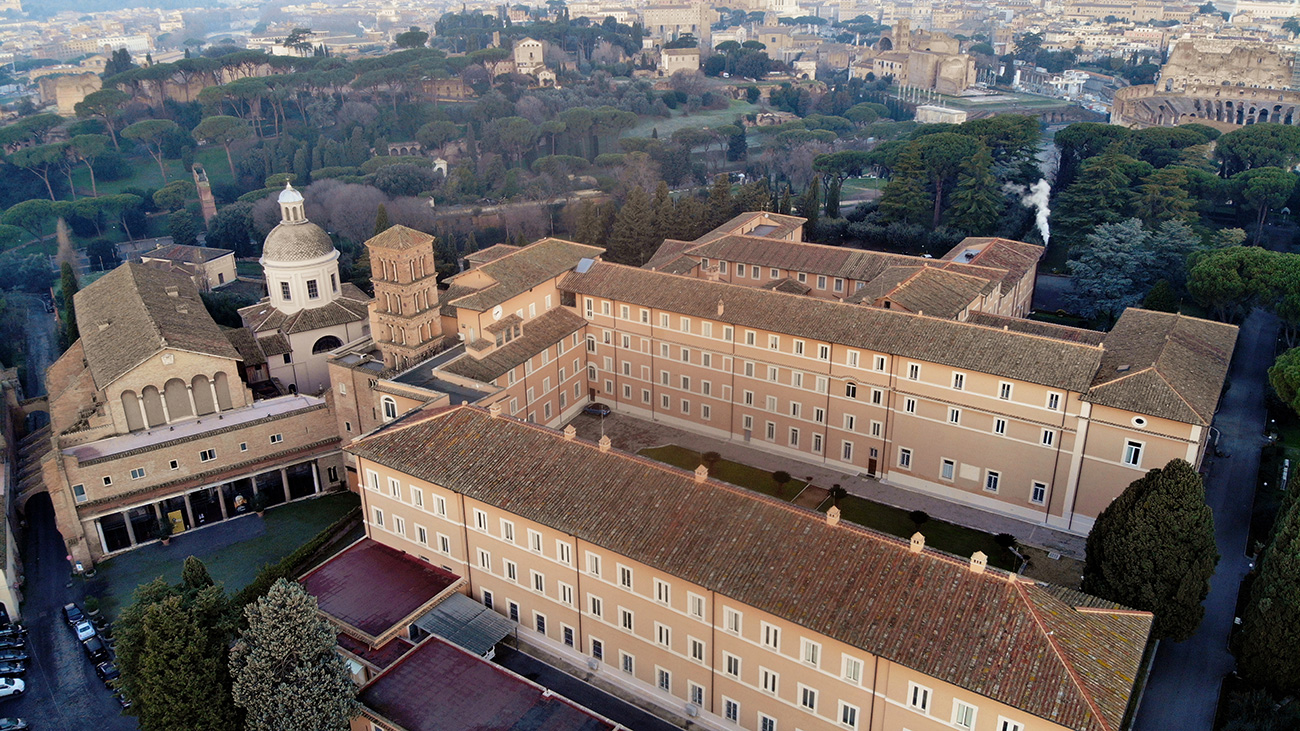
The Monastic Complex of Sts. John and Paul (400-1773)
Fr. Tito Paolo Zeca
On the foundation of the domus, the Roman houses beneath the Basilica, in which the soldier brothers John and Paul were martyred at the time of the Emperor Julian the Apostate (+ 363), first an oratory was built and then a basilica.
Next to it, there was also a building to offer hospitality to the devotees of the cult of martyrs and to house those who would care for the sacred buildings.
However, there is little information about the buildings and their caretakers until about the year 1000. We know that the first religious dwelling was built next to the basilica on the northern side, of which there are very few traces remaining because it became amalgamated into subsequent buildings and structures of the Basilica.
The documentation is more reliable after 1118 when the rebuilding and expansion of the monastery that eventually developed was completed. It extended towards the bell tower and used the mighty substructures of the Claudianum (the rudiments of the Temple of Claudius).
The Titular, Cardinal Theobald, undertook this work at the time of Pope Paschal II (1099-1118). The Basilica and monastery, in fact, had been badly damaged by looting done by the militias of Robert Guiscard in 1084.
The stylistic changes, in Cistercian style, and the jurisdiction of the clergy of the basilica was under the Abbey of Casamari. They provide valuable information about the monastic community that resided here. In the 15th century, a period of serious decline for the city, the basilica and the monastery fell into serious disrepair.
The surviving monks were powerless to save the basilica and monastery from ruin.
The Titular, Cardinal Latino Orsini, replaced the monks with the Gesuati friars of Blessed Giovanni Colombini from Siena. Blessed Antonio Bettini (+ 1487), founded and governed the first community on the Caelian Hill.
The Gesuati resided here from 1454 to 1668. Here their ministries were typical of their movement (which later became an Order), namely works of charity and assistance to the poorest and neediest, particularly during plagues and famines (they were called the "Acquavite Fathers", because of the distilled solution that they confected and used as a disinfectant and fragrance). Between 1624 –1630, the community numbered 50 religious. The monastery consisted of two courtyards, a vegetable garden, an orchard, two wells and a cistern, plus other adjacent land and buildings. The Gesuati were suppressed by Clement IX in 1668.
From 1668 to 1671, it seems that there were Carmelite (Filippine) nuns. Then from 1671/2 to 1697, Dominican friars from England resided here. Very few religious remained until the arrival of the Vincentians (1697-1773).
The English Dominicans were invited to Sts. John and Paul by Cardinal Philip T. Howard of Norfolk, O.P. (+ 17 June 1694, Rome), to found a College, but nothing came of it. Howard brought significant changes to the monastic buildings, particularly area of the current main entrance.
Innocent XII (Antonio Pignatelli) then gave then Sts. John and Paul to the sons of Saint Vincent de Paul, called Vincentians or Fathers of the Mission, “to prepare young student seminarians—for their novitiate and other functions, which require more solitude”.
The House also included gardens and a good income that ensured the life of the community composed mainly of religious in formation. They provided service to the basilica and to retreatants. At the beginning, the community included 19 religious (priests, students, religious Brothers).
Finally, in 1773 the Passionists arrived. The Vincentians had decided, after the suppression of the Society of Jesus (Jesuits), to go to former Jesuit church/novitiate of Sant'Andrea al Quirinale. From there they eventually were transferred to San Silvestro al Quirinale.
On 9 December 1773, Paul of the Cross, together with his fellow religious, 17 in all (who had previously lived in the Hospice of the Holy Crucifix located on the left side of Via San Giovanni in Laterano, until the piazza of the same name was redesigned), took possession of the venerable old buildings and began immediately to observe the community horarium according to the Rule of the Institute.
In addition to ministering in the Basilica and receiving retreatants, the religious of the “Celimontana” community devoted themselves to the service of the entire Congregation as a Generalate. However, they not disregard preaching, both in the city and in the surrounding Roman countryside. They also served at the nearby Hospital of San Giovanni. Their ministry was always valued and appreciated and consequently in great demand.